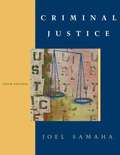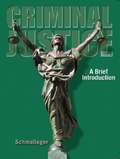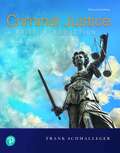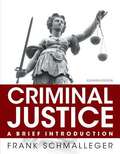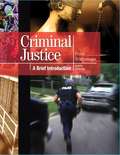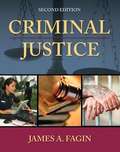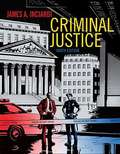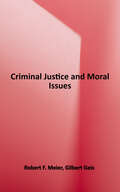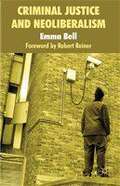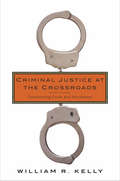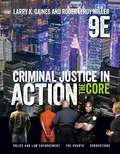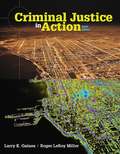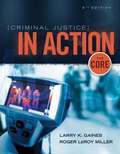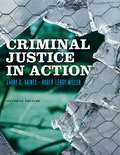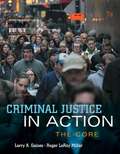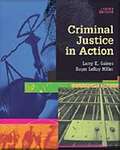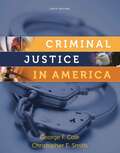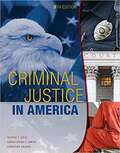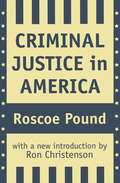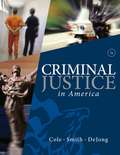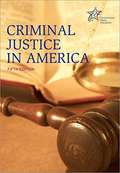- Table View
- List View
Criminal Justice
by Joel SamahaThe book covers the traditional core of the criminal justice system (police, courts, and corrections), focusing on the decision- making and evaluation of criminal justice policies and practices. The author has taken a provocative view of the CJ system to encourage critical thinking, providing a realistic look at problems as well as new programs which offer promise for the future.
Criminal Justice: A Brief Introduction (6th Edition)
by Frank SchmallegerCriminal Justice: A Brief Introduction 6e continues to offer a trusted, authoritative and impeccably researched introduction to the criminal justice system in America. This book's freedom vs. safety theme, its unmatched timeliness, and its coverage of the newest criminal justice trends and technology helps readers think critically about the criminal justice system in a time when the issue of freedom vs. safety has never been more critical. The book's primary theme discusses the balance of freedom and safety between our society and the criminal justice system. Terrorism and security issues include up-to-date coverage of police terrorism response, including the most recent information on counter terrorism initiatives by America's police. Other hot topics include all the latest crime statistics, court cases, trends in the system and criminal justice news. Extensive coverage of technology and crime includes the latest law enforcement technology used to combat crime and technology used by criminals to commit crimes. Also includes extensive discussion of the juvenile justice system. For anyone with current or future criminal justice careers or those in law enforcement positions.
Criminal Justice: A Brief Introduction
by Frank SchmallegerCriminal Justice is the gold standard of criminal justice texts. It examines crime in the US, with a focus on police, courts and corrections. You'll contemplate the fine line separating freedom from security and evaluate the strengths and weaknesses of the US justice system. A wealth of internet resources along with author tweets (@schmalleger) build on central ideas in the text, while keeping pace with a continually changing field. The revised 13th Edition emphasizes the need for systemic change. It includes revised coverage of large-scale crimes pervasive in the US, as well as policing issues and challenges, sentencing guidelines, and state laws redefining the age of criminal responsibility.
Criminal Justice: A Brief Introduction
by Frank J. SchmallegerThe gold standard for criminal justice texts Criminal Justice: A Brief Introduction, Eleventh Edition offers a contemporary, authoritative look at crime in America with a focus on police, courts, and corrections. To make information resonate with students, Schmalleger asks readers to consider the balance between freedom and security issues and evaluate the strengths and weaknesses of the American justice system as it adapts to cultural, political, and societal changes. An interactive website along with author tweets (@schmalleger) extends chapter material and provides up-to-the minute information on this ever-evolving field. Its unifying theme, unmatched timeliness, and coverage of trends and technology make this text the standard by which all other brief texts are judged. Personalize learning with MyCJLab MyCJLab is an online homework, tutorial, and assessment program designed to work with this text to engage students and improve results. This powerful homework and test manager lets you create, import, and manage online homework assignments, quizzes, and tests that are automatically graded. You can choose from a wide range of assignment options, including time limits, proctoring, and maximum number of attempts allowed. The bottom line: MyLab means less time grading and more time teaching.
Criminal Justice: A Brief Introduction (9th Edition)
by Frank J. SchmallegerThe first and BEST-SELLING brief introduction to criminal justice text, Criminal Justice: A Brief Introduction 9e offers instructors and students a trusted, authoritative and impeccably researched introduction to police, courts, and corrections. Designed with a new visual approach, this edition integrates graphic art with the important concepts and ideas of criminal justice. Its unifying theme, its unmatched timeliness and its coverage of trends and technology makes this text THE standard by which all other brief texts are judged.
Criminal Justice (2nd edition)
by James A. FaginThis book introduces students to the real world of criminal justice as Fagin uses clear and simple examples drawn from decades of experience to bring criminal justice alive and places the criminal justice system in the broader context of American government.
Criminal Justice (8th Edition)
by James A. InciardiA textbook for an introductory criminal justice course. Beyond the updating of facts, court decisions, issues, and research findings, this edition addresses the current "drug driven" nature of all phases of the criminal justice process--the result of the US "war on drugs" during the 1980s and early 1990s.
Criminal Justice (9th Edition)
by James A. InciardiAn internationally recognized scholar and author, James A. Inciardi presents a solid overview of the structure, processes, and problems of the criminal justice system in the United States. Inciardi brings his significant field and research experience to bear on the revision of this successful textbook; his research background, his privileged access to national data, and his story-telling style of writing guarantee a unique perspective to criminal justice. The ninth edition includes many new "Famous Criminals" sections, added coverage on media and criminal justice, and updated exhibits that showcase research, historical perspectives, current events, and the viewpoints of victims in the criminal justice system.
Criminal Justice and Moral Issues
by Robert F. Meier Gilbert GeisThis text addresses the following two questions: "What kinds of problems can the law solve?" and "What kinds of problems does the law create?" Using these questions as starting points, Meier and Geis evenhandedly explore the role and function of law relating to six major issues that often divide Americans today: prostitution, drug use, homosexuality, abortion, pornography, and gambling. Statutes and public opinion have shifted dramatically over recent decades in regard to these behaviors. The book details these developments and offers explanations of why they have occurred. Some people view all or some of these behaviors as acts that ought to be permitted, as part of individual freedom. Others find one, some, or all of them to be genuine threats to the country's social and moral fiber and believe that they ought to be criminalized. Still others maintain that action ought to be taken to limit some of the behaviors, but that using the criminal justice system is not the best way to proceed. Meier and Geis' provocative book offers sophisticated, in-depth discussions of these issues, and then reviews the conflicting opinions about the proper role of criminal law in dealing with them. It is written in straightforward, jargon-free language, providing an ideal background for exploring the facts and views regarding what are often contentious concerns. The book increases student understanding through the abundant use of relevant illustrations, examples, and case studies.
Criminal Justice and Neoliberalism
by Emma BellAs criminal justice has become one of the most hotly-debated issues in contemporary Western politics, the punitive capacity of the State has intensified. This book seeks to test the validity of claims that the UK has experienced a 'punitive turn' over the past two decades and to situate recent trends in the specific context of neoliberalism. It is argued that, whilst particular cultural and political factors are relevant, it is ultimately neoliberalism which has led to the recent intensification of punishment, undermining government's capacity to deal with the structural causes of criminality, leading it to use the crime problem as a wedge issue in a vain attempt to appeal to the electorate across class lines and forcing it to submit the criminal justice system, as all other public services, to the processes of commodification.
Criminal Justice at the Crossroads: Transforming Crime and Punishment
by William KellyOver the past forty years, the criminal justice system in the United States has engaged in a very expensive policy failure, attempting to punish its way to public safety, with dismal results. So-called "tough on crime" policies have not only failed to effectively reduce crime, recidivism, and victimization but also created an incredibly inefficient system that routinely fails the public, taxpayers, crime victims, criminal offenders, their families, and their communities.Strategies that focus on behavior change are much more productive and cost effective for reducing crime than punishment, and in this book, William R. Kelly discusses the policy, process, and funding innovations and priorities that the United States needs to effectively reduce crime, recidivism, victimization, and cost. He recommends proactive, evidence-based interventions to address criminogenic behavior; collaborative decision making from a variety of professions and disciplines; and a focus on innovative alternatives to incarceration, such as problem-solving courts and probation. Students, professionals, and policy makers alike will find in this comprehensive text a bracing discussion of how our criminal justice system became broken and the best strategies by which to fix it.
Criminal Justice at the Crossroads
by William R. KellyOver the past forty years, the criminal justice system in the United States has engaged in a very expensive policy failure, attempting to punish its way to public safety, with dismal results. So-called "tough on crime" policies have not only failed to effectively reduce crime, recidivism, and victimization but also created an incredibly inefficient system that routinely fails the public, taxpayers, crime victims, criminal offenders, their families, and their communities.Strategies that focus on behavior change are much more productive and cost effective for reducing crime than punishment, and in this book, William R. Kelly discusses the policy, process, and funding innovations and priorities that the United States needs to effectively reduce crime, recidivism, victimization, and cost. He recommends proactive, evidence-based interventions to address criminogenic behavior; collaborative decision making from a variety of professions and disciplines; and a focus on innovative alternatives to incarceration, such as problem-solving courts and probation. Students, professionals, and policy makers alike will find in this comprehensive text a bracing discussion of how our criminal justice system became broken and the best strategies by which to fix it.
Criminal Justice In Action: The Core
by Larry K. Gaines Roger MillerConcise and career focused, with cutting-edge topic coverage, the exciting new CRIMINAL JUSTICE IN ACTION: THE CORE, 9th Edition, delivers an accessible, applied, and real-world introduction to the field. Gripping photos and an engaging magazine-like layout make this succinct text ideal for a fast-paced course and visual learners. The text presents topics and cases straight from today's headlines, putting students in the center of the action with vivid, relatable examples that demonstrate the core principles of the American justice system at work. This edition features extensive ethics coverage, practical career guidance (including how to research professions on LinkedIn), and thought-provoking new material on controversial social issues and criminal justice policies. What’s more, the MindTap that accompanies this text helps students practice and master techniques and key concepts while engaging them with video cases, career-based decision-making scenarios, visual summaries, and more.
Criminal Justice In Action
by Larry K. Gaines Roger Leroy MillerThe Ninth Edition of CRIMINAL JUSTICE IN ACTION places you in the center of the action and helps you excel in your criminal justice course. You'll explore vivid real-life applications that clarify key concepts, and read about the many exciting new career opportunities that the field now offers. Chapter material will make sense, thanks to straight-from-the-headlines vignettes that show the relevance of upcoming discussions. Choosing what's important to remember is a snap with each chapter's numbered objectives, which are reinforced throughout the chapter as well as in the book's supplementary items.
Criminal Justice In Action: The Core (Eighth Edition)
by Larry K. Gaines Roger LeRoy MillerThe Eighth Edition of CRIMINAL JUSTICE IN ACTION places you in the center of the action and helps you learn about criminal justice. You'll explore vivid real-life applications that clarify key concepts and read about the many exciting new career opportunities that the field now offers. Chapter material will make sense, thanks to straight-from-the-headlines vignettes that begin every chapter. Knowing what's important is a snap with each chapter's numbered objectives, which are reinforced throughout the chapter.
Criminal Justice in Action: The Core (Criminal Justice Ser.)
by Larry K. Gaines Roger LeRoy MillerNIMAC-sourced textbook
Criminal Justice in Action
by Larry K. Gaines Roger Leroy MillerWith riveting examples taken from today's headlines, cutting-edge material on careers, new ways to help students think and write critically, and an engaging magazine-style design, this text is perfect for today's busy students and instructors.
Criminal Justice In Action: The Core
by Larry K. Gaines Roger Leroy MillerWith an engaging magazine-like format, and riveting examples straight from today's headlines, CRIMINAL JUSTICE IN ACTION: THE CORE, 7th puts you in the center of the action. Providing just the right depth of coverage, this succinct book uses vivid cases and current events to demonstrate the core principles of the American justice system at work.
Criminal Justice in Action (3rd Edition)
by Larry K. Gaines Roger Leroy MillerThis textbook introduces the criminal justice system and particularly examines the roles played by police, courts, and corrections. Gaines (California State University) and Miller discuss measurements and explanations of crime, criminal law, police organization, pretrial procedures, criminal trials, punishment and sentencing, probation and community corrections, juvenile justice, the drug war, and cybercrime. The fifth edition adds a chapter on homeland security and sections on police strategies, jail overcrowding, and school violence. Annotation ©2008 Book News, Inc. , Portland, OR (booknews. com)
Criminal Justice In America
by George F. Cole Christopher E. SmithCole and Smith's CRIMINAL JUSTICE IN AMERICA, Sixth Edition, lets you experience the real-world excitement of this dynamic field while helping you excel in your course with the support of proven, integrated study tools. In this engaging, reader-friendly text, you'll learn about new career opportunities in criminal justice and read true stories of offenders and their experiences within the system. You'll also learn about the crucial role that public policy plays in the criminal justice system and explore the hot issues that are changing the face of criminal justice today and shaping its future.
Criminal Justice In America
by George F. Cole Christopher E. Smith Christina DeJongCRIMINAL JUSTICE IN AMERICA, Ninth Edition, lets you experience the real-world excitement of this dynamic field while helping you to excel in your course with the support of proven, integrated study tools. In this engaging, reader-friendly text, you'll read true stories of offenders and their experiences within the system. You'll also learn about the crucial role that public policy plays in the criminal justice system and explore the hot issues that are changing the face of criminal justice today -- and shaping its future. Through contemporary examples, such as the Black Lives Matter movement, efforts to reform sentencing and reduce prison populations, and the impact of new technologies, this book highlights societal developments that pose new challenges for criminal justice professionals. What's more, the MindTap that accompanies this text helps you practice and master techniques and key concepts while engaging you with video cases, career-based decision-making scenarios, visual summaries, and more.
Criminal Justice in America (Quality Paperbacks Ser.)
by Roscoe PoundRoscoe Pound believed that unless the criminal justice system maintains stability while adapting to change, it will either fossilize or be subject to the whims of public opinion. In Criminal Justice in America, Pound recognizes the dangers law faces when it does not keep pace with societal change. When the home, neighborhood, and religion are no longer capable of social control, increased conflicts arise, laws proliferate, and new menaces wrought by technology, drugs, and juvenile delinquency flourish. Where Pound saw the influence of the motion pictures as part of the "multiplication of the agencies of menace," today we might cite television and the Internet. His point still holds true: The "old machinery" cannot meet the evolving needs of society. In Criminal Justice in America,Pound points out that one aspect of the criminal justice problem is a rigid mechanical approach that resists change. The other dimension of the problem is that change, when it comes, will result from the pressure of public opinion. Justice suffers when the public is moved by the oldest of public feelings, vengeance. This can result in citizens taking the law into their own hands--from tax evasion to mob lynchings--as well as in altering the judicial system--from sensationalizing trials to producing wrongful convictions. Ron Christenson, in his new introduction, discusses the evolution of Roscoe Pound's career and thought. Pound's theories on jurisprudence were remarkably prescient. They continue to gain resonance as crimes become more and more sensationalized by the media.Criminal Justice in America is a fascinating study that should be read by legal scholars and professionals, sociologists, political theorists, and philosophers.
Criminal Justice in America (7th Edition)
by George F. Cole Christopher E. Smith Christina DejongThe book is designed to provide thorough introduction and comprehensive coverage to the dynamics of the American criminal justice system and illuminates contemporary issues and problems.
Criminal Justice In America (Fifth Edition)
by Bill Hayes Marshall Croddy Todd ClarkNo matter who you are, crime affects your life. As a student, your school might be vandalized or your wallet stolen. Statistically, chances are good that sometime in your life you will be a crime victim. As a taxpayer, you will be required to contribute money in the fight against crime or to repair the damage it does. As a voter, you will be asked to choose candidates based in part, at least, on their views about solutions to crime. Everyone agrees that crime is a serious problem. Few agree about its causes or solutions. <p><p> Although the debate over the causes and solutions to crime will probably never end, society has evolved a criminal justice system for dealing with crime. Two areas of jurisprudence are essential to understanding this system: criminal law and criminal procedure.
Criminal Justice in Divided America: Police, Punishment, and the Future of Our Democracy
by David A. SklanskyHow a broken criminal justice system has fueled the crisis of American democracy, and how we can address both problems together.American criminal justice is in crisis. Prisons are swollen, confidence in police has plummeted, and race- and class-based biases distort every aspect of the system. American democracy is in crisis, too, as the chasm of loathing and incomprehension that divides political factions grows ever wider and deeper. Legal scholar and former prosecutor David A. Sklansky argues that these crises are deeply intertwined. And if the failures of American criminal justice are near the heart of our political divides, then reforming the system is essential for repairing our democracy.Criminal Justice in Divided America shows how police, courts, and prisons helped to break American democracy and how better approaches to public safety and criminal accountability can help to repair it. Engaging critically with concerns from both the left and the right, Sklansky lays out a clear and deeply researched agenda for reforming police departments, prosecutors’ offices, criminal trials, and punishment. Sklansky seeks pragmatic solutions that take account of political realities: the lofty ideal of empowering “the people” or “the community” can mean little when members of the public or the community disagree. While efforts to “defund” the police have exacerbated political conflicts without addressing the underlying problem of how and when force should be used to protect public safety, reforms aimed at improving police accountability, restraining prosecutorial power, and expanding the role of juries can bring together warring parties who share a concern for justice.Ultimately, Sklansky argues, reform must be rooted in a strong commitment to pluralism—bridging political divides rather than worsening them, strengthening democracy, and securing the broad support that enables durable change.
